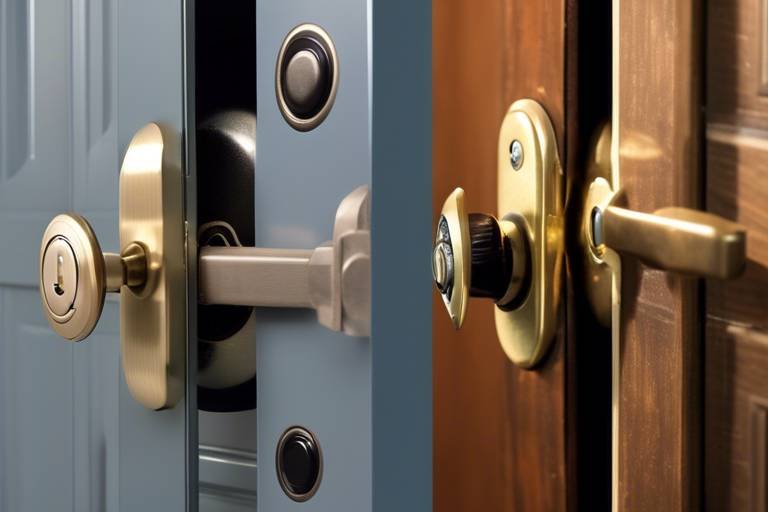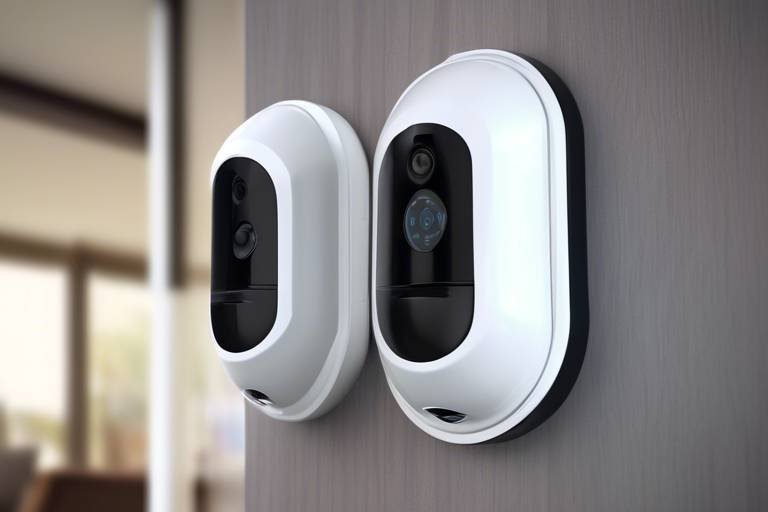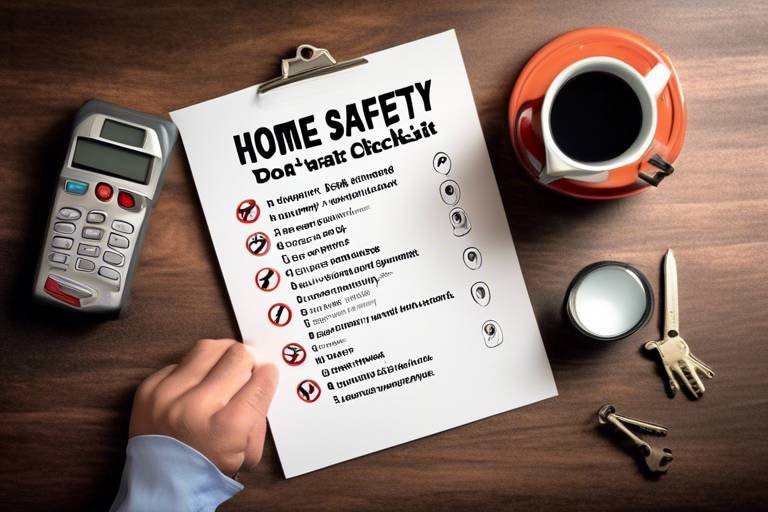Pros and Cons of Security Door Installation
When it comes to home security, installing a security door is often at the top of the list for homeowners looking to enhance their safety. These doors are designed to withstand forced entry, making them a formidable barrier against intruders. But before you rush to install one, it’s essential to weigh the pros and cons to make an informed decision. After all, your home is your sanctuary, and ensuring its safety should come with careful consideration.
On the plus side, security doors offer a range of benefits that can significantly enhance your home’s protection. They are typically made from durable materials like steel or reinforced fiberglass, providing a robust defense against break-ins. Furthermore, many security doors come equipped with advanced locking mechanisms and features, such as deadbolts and multi-point locking systems, which can deter even the most determined burglars. Not only do they keep unwanted visitors at bay, but they can also improve your home’s overall security profile, potentially increasing its value on the real estate market. Imagine your home as a fortress—these doors act as the first line of defense against any threat.
However, it’s important to acknowledge that there are potential drawbacks to consider as well. For starters, the initial cost of purchasing and installing a security door can be quite high. Depending on the materials and features you choose, prices can vary significantly, leading to a hefty investment upfront. Additionally, while security doors are functional, they may not always align with your home’s aesthetic. Some homeowners find that these doors can appear bulky or industrial, which might clash with the overall design of their property. So, while you’re beefing up security, you might also be compromising on style.
Ultimately, the decision to install a security door should be based on a balance of these pros and cons. Are you willing to invest in your home’s safety, even if it means shelling out more cash? Do you prioritize security over aesthetics? These questions will guide you in making the right choice. As you consider these factors, remember that the peace of mind that comes with enhanced security is invaluable, making it a worthy investment for many homeowners.
Security doors provide enhanced protection against intruders, improve home security, and can even increase property value. Understanding these benefits is crucial for homeowners considering installation.
While security doors offer numerous advantages, there are potential drawbacks, including costs and aesthetic concerns. This section highlights the challenges homeowners may face with installation.
The price of security doors can vary significantly based on materials and features. This subsection discusses budgeting for installation and potential long-term savings.
Professional installation can add to the overall expense. Homeowners should weigh the costs of DIY versus hiring a professional to ensure proper installation.
Security doors may require ongoing maintenance, which can incur additional costs. This section outlines what homeowners should anticipate regarding upkeep.
Security doors can alter the appearance of a home. Here, we discuss how to choose a design that complements your home while maintaining security.
Selecting the appropriate security door involves considering materials, styles, and features. This section provides guidance on making the best choice for your needs.
Different materials offer varying levels of security and durability. This subsection reviews common materials used in security doors and their benefits.
Finding a security door that matches your home’s aesthetic is essential. Here, we explore various styles and design options available in the market.
Understanding the installation process is vital for homeowners. This section outlines the steps involved in installing a security door, whether DIY or professional.
For those considering a DIY approach, this subsection provides practical tips and guidance for successfully installing a security door.
Hiring a professional can ensure a secure installation. This section discusses what to look for in a contractor and the benefits of expert installation.
Q: Are security doors worth the investment?
A: Yes, security doors provide enhanced protection and can increase property value, making them a worthwhile investment for many homeowners.
Q: Can I install a security door myself?
A: While DIY installation is possible, hiring a professional ensures proper installation and security.
Q: Do security doors require maintenance?
A: Yes, regular maintenance is recommended to ensure the door remains functional and effective over time.

Benefits of Security Doors
When it comes to protecting your home, security doors are like the trusty knight guarding your castle. They stand between you and potential intruders, providing a robust barrier that enhances your peace of mind. One of the most significant benefits of installing security doors is their ability to deter break-ins. Intruders often look for the easiest targets, and a well-installed security door can make your home less appealing. It's like putting up a "No Trespassing" sign that says, "Not here, buddy!"
Another advantage is the enhanced safety they provide. Security doors are typically made from durable materials such as steel or reinforced aluminum, which can withstand significant force. This means that not only do they keep intruders out, but they also provide a sense of safety for you and your family. Imagine coming home after a long day and knowing that your door is a fortress, not just a flimsy barrier.
Moreover, security doors can improve your home's overall security system. When combined with other security measures like alarms and cameras, they create a comprehensive defense strategy. This layered approach is akin to building a multi-tiered fortress, where each layer adds another level of protection.
And let's not forget about the potential increase in property value. Homes equipped with security features are often more attractive to potential buyers. In a market where safety is a top priority, having a security door can make your home stand out. Think of it as adding a shiny new badge to your home’s profile; it not only enhances aesthetics but also communicates that your home is a safe haven.
Lastly, security doors can also provide energy efficiency. Many modern security doors come with insulation features that help regulate indoor temperatures. This means you can save on heating and cooling costs while enjoying a comfortable living environment. It's like getting two benefits for the price of one—security and savings!
In summary, the benefits of security doors extend far beyond just keeping intruders at bay. They offer a combination of safety, improved security, potential property value increase, and even energy efficiency. So, if you're contemplating whether to install one, consider these advantages as you make your decision.

Potential Drawbacks
While the idea of installing a security door might sound like a no-brainer, it's essential to consider the that can accompany this decision. After all, no solution is perfect, and understanding the challenges can help homeowners make more informed choices. One of the most significant concerns is the cost associated with purchasing and installing a security door. Depending on the materials and features you choose, the price can vary widely, and it's crucial to budget accordingly. For instance, a basic steel security door may cost less than a high-end model with advanced locking mechanisms and decorative features. This variability can lead to unexpected expenses, especially if you're aiming for a more robust option.
Another aspect to consider is the aesthetic impact of a security door. While these doors are designed primarily for protection, they can sometimes clash with the overall look of your home. Imagine a beautiful Victorian house with a stark, industrial security door slapped on the front. It could disrupt the home's charm and character. Therefore, it's essential to select a door that not only provides security but also complements your home's architectural style. This can be a delicate balancing act, as the most secure options may not always be the most visually appealing.
Moreover, the installation process can also pose challenges. Many homeowners opt for professional installation to ensure that the door is fitted correctly and securely. However, this can significantly increase your overall costs. If you're considering a DIY approach, you need to be confident in your skills, as improper installation can lead to vulnerabilities, negating the very purpose of having a security door in the first place. It's worth weighing the pros and cons of DIY versus hiring a professional to find the best solution for your situation.
Lastly, ongoing maintenance expenses should not be overlooked. Security doors, like any other component of your home, require upkeep to ensure they function effectively. This might include regular inspections, lubrication of hinges, and even repainting if the door is exposed to the elements. These costs can add up over time, so it's essential to factor them into your budget when considering a security door.
In summary, while security doors offer numerous benefits, they also come with potential drawbacks that homeowners must consider. From costs and aesthetic concerns to installation challenges and maintenance, understanding these factors can help you make the best decision for your home and family.
- What is the average cost of a security door? The cost can range from a few hundred to several thousand dollars, depending on materials and features.
- Can I install a security door myself? Yes, but ensure you have the necessary skills and tools to do it correctly.
- Do security doors require maintenance? Yes, regular maintenance is essential to keep them functioning effectively.
- Are security doors customizable? Many manufacturers offer a variety of styles and designs to fit different home aesthetics.

Cost Considerations
When it comes to installing security doors, play a pivotal role in the decision-making process. Homeowners often find themselves grappling with the price tag attached to these protective barriers. The cost of security doors can vary significantly based on a multitude of factors, including the materials used, the complexity of the design, and any additional features that enhance security. It's essential to understand that while the initial investment might seem steep, the long-term benefits often outweigh the costs.
To give you a clearer picture, let's break down some of the key aspects that influence the overall cost:
| Cost Factor | Estimated Price Range |
|---|---|
| Material Type | $100 - $2,000 |
| Design Complexity | $50 - $500 |
| Additional Features (e.g., locks, screens) | $20 - $300 |
| Installation (DIY vs. Professional) | $0 - $1,500 |
As you can see from the table, the range of costs can be quite broad. For instance, if you opt for a basic steel door, you might find yourself at the lower end of the spectrum. However, if you want something more customized or made from high-end materials like fiberglass or wrought iron, expect to pay a premium.
One significant factor to consider is whether you will be installing the door yourself or hiring a professional. DIY installation can save you money upfront, but it also comes with its own set of challenges. If you're not handy or lack the necessary tools, you might end up spending more in the long run fixing mistakes. On the other hand, hiring a professional ensures that the job is done correctly, which can provide peace of mind and potentially save you from future expenses related to improper installation.
Moreover, don’t forget about maintenance expenses. While security doors are designed to be durable, they still require upkeep. Regular cleaning, lubrication of hinges, and occasional repainting (if applicable) can add to your overall costs. It’s crucial to factor in these ongoing expenses when budgeting for your new security door.
In summary, understanding the cost considerations surrounding security door installation is vital. By weighing the initial investment against the long-term benefits and potential savings, homeowners can make an informed decision that enhances their home security without breaking the bank.

Installation Costs
When considering the installation of security doors, one of the first things that come to mind is the cost. It's essential to understand that the price of security doors can vary significantly based on several factors. These include the type of material you choose, the design, and any additional features you may want. For instance, a basic steel security door might cost less than a high-end model made from reinforced fiberglass. To help you get a clearer picture, here’s a rough breakdown of what you might expect:
| Material | Average Cost |
|---|---|
| Steel | $150 - $500 |
| Aluminum | $200 - $600 |
| Fiberglass | $300 - $800 |
| Wood | $400 - $1,200 |
In addition to the door itself, you’ll need to factor in . Hiring a professional can add anywhere from $100 to $300 to your total expenses, depending on the complexity of the installation. While you might be tempted to save money by going the DIY route, it's crucial to weigh the potential risks. Improper installation can lead to security vulnerabilities, which defeats the purpose of having a security door in the first place.
Moreover, if you're considering additional features—like reinforced locks, custom designs, or smart technology integration—these can also drive up the total cost. It’s not uncommon for homeowners to spend upwards of $1,000 for a high-quality security door with all the bells and whistles. So, while the initial investment might seem steep, think of it as a long-term investment in your home’s safety.
Ultimately, understanding these costs will help you budget effectively and choose a security door that meets both your financial and safety needs. Remember, the goal is to achieve peace of mind without breaking the bank!
- What is the average lifespan of a security door? Most security doors can last anywhere from 20 to 30 years with proper maintenance.
- Can I install a security door myself? Yes, but it requires some basic skills and tools. If you’re unsure, hiring a professional is advisable.
- Do security doors come with warranties? Many manufacturers offer warranties, typically ranging from 1 to 10 years, depending on the product.

Maintenance Expenses
When considering the installation of a security door, it’s essential to factor in the that come along with it. Just like any other home feature, security doors require regular upkeep to ensure they function effectively and continue to provide the protection you expect. Think of it this way: a security door is like a car; if you don’t maintain it, you can’t expect it to keep running smoothly.
One of the main maintenance tasks involves checking the door’s locking mechanism. Over time, locks can become stiff or jammed, which can compromise your security. Regular lubrication of the lock and hinges is necessary to prevent this from happening. You might also want to inspect the door frame and surrounding areas for any signs of wear or damage. If you notice any issues, addressing them early can save you from more significant expenses down the line.
Another aspect to consider is the finish of the door. Depending on the material of your security door, you may need to repaint or refinish it periodically to keep it looking its best and to protect it from the elements. For example, steel doors may require a fresh coat of paint every few years, while wooden doors might need more frequent treatment to prevent rot and warping.
Additionally, if your security door has any glass panels, you’ll want to ensure they are clean and intact. Cracks or chips not only detract from the door’s appearance but can also be a security risk. Replacing glass panels can be costly, so regular inspections are advisable.
To give you a clearer picture of potential maintenance costs, here’s a simple breakdown:
| Maintenance Task | Estimated Cost |
|---|---|
| Lock Lubrication | $10 - $20 |
| Repainting Steel Door | $50 - $150 |
| Wood Treatment | $30 - $100 |
| Glass Panel Replacement | $100 - $300 |
In summary, while security doors can significantly enhance your home’s safety, it’s crucial to be aware of the ongoing maintenance costs involved. By planning for these expenses, you can ensure that your investment in a security door continues to pay off in the long run, providing peace of mind and protection for your home.
- How often should I maintain my security door? Regular maintenance is recommended at least once a year, but it's wise to inspect it more frequently, especially after severe weather.
- Can I perform maintenance myself? Yes, many maintenance tasks can be done by homeowners, such as lubricating locks and checking for damage. However, for more complex issues, consider hiring a professional.
- What materials require the most maintenance? Wooden doors typically require more maintenance than steel or fiberglass doors, which are generally more durable and weather-resistant.

Aesthetic Impact
When it comes to installing security doors, one of the most significant considerations is their on your home. After all, the first thing people notice about your house is its appearance. A security door can either enhance or detract from your home’s overall look, so it’s essential to choose wisely. Think of it like dressing up for an important event; the right outfit can elevate your presence, while the wrong one can leave a less favorable impression.
Security doors come in a variety of styles, colors, and materials, allowing homeowners to find options that blend seamlessly with their existing architecture. For instance, a sleek, modern security door can give a contemporary home a polished look, while a traditional wrought-iron design can add a touch of elegance to a classic-style house. It's crucial to consider how the door will fit into your home's aesthetic. You wouldn’t wear a tuxedo to a beach party, right? Similarly, your security door should match the vibe of your home.
Moreover, many manufacturers offer customizable options, allowing you to choose specific features such as decorative glass panels or unique finishes. This customization can help maintain the visual harmony of your home while ensuring your safety. Imagine adding a beautiful security door that not only secures your home but also becomes a conversation starter for guests. It’s all about finding that perfect balance between style and security.
However, it’s essential to be cautious about the aesthetic impact of security doors. Some homeowners may worry that a bulky or industrial-looking door could make their home feel fortress-like, which is not the vibe most of us want to project. To combat this, consider opting for designs that are both functional and visually appealing. Here are a few tips to help you choose the right security door:
- Research Options: Look for doors that have a good balance between security features and aesthetic appeal.
- Consult with Professionals: Don’t hesitate to seek advice from contractors or designers who can recommend styles that complement your home.
- Visit Showrooms: Seeing doors in person can help you visualize how they will look at your home.
In conclusion, while security doors are primarily about safety, their aesthetic impact should not be overlooked. By choosing a door that complements your home’s style, you can enhance its curb appeal while ensuring your family’s safety. Remember, a beautiful home is not just about how it looks on the outside; it’s also about feeling secure and comfortable within it.
1. Do security doors come in different styles?
Yes, security doors are available in various styles, including modern, traditional, and custom designs to fit your home’s aesthetic.
2. Can I paint my security door?
Most security doors can be painted, but it's essential to use the right type of paint that adheres well to the material of the door.
3. Are security doors customizable?
Yes, many manufacturers offer customization options, allowing you to choose features like color, design, and materials.
4. Will a security door affect my home’s value?
A well-chosen security door can potentially increase your home’s value by enhancing its curb appeal and security features.
5. How do I maintain the aesthetic of my security door?
Regular cleaning and maintenance will help keep your security door looking its best. Additionally, consider refinishing or repainting as needed.

Choosing the Right Security Door
When it comes to , it’s not just about picking the first one you see. It’s about understanding your needs, the level of security you require, and how the door fits into your home’s overall aesthetic. Think of it like buying a new pair of shoes; you wouldn’t just grab the first pair off the shelf! You’d want to consider style, comfort, and durability. In the same vein, selecting a security door involves a careful balance of function and form.
First and foremost, you need to consider the material of the door. Security doors come in a variety of materials, each offering different levels of protection. For instance, steel doors are known for their strength and durability, making them a popular choice for homeowners looking for maximum security. On the other hand, aluminum doors can be lightweight yet strong, providing a good balance between security and ease of use. Here’s a quick comparison of common materials:
| Material | Strength | Durability | Cost |
|---|---|---|---|
| Steel | High | Very High | Medium to High |
| Aluminum | Medium | Medium | Medium |
| Fiberglass | Medium | High | Medium |
Next, let’s talk about style and design. Your security door should not only protect your home but also enhance its curb appeal. Imagine a beautiful front yard with a security door that looks out of place—yikes! It can really detract from your home’s overall look. Fortunately, many manufacturers offer a range of styles, from modern to traditional, so you can find something that complements your home’s architecture. You might even consider a door with decorative elements like glass inserts or unique hardware to add a touch of personality.
Don’t forget about the features that come with the door. Many security doors come equipped with advanced locking systems, which can provide an extra layer of protection. Look for features like deadbolts, multi-point locking systems, and even smart locks that can be controlled via your smartphone. These features not only enhance security but also offer convenience—who wouldn’t love the ability to lock their door remotely?
Lastly, it’s essential to think about installation. Whether you’re going the DIY route or hiring a professional, proper installation is crucial for ensuring that your security door functions as intended. A poorly installed door can be an invitation for trouble, defeating the purpose of investing in a security door in the first place. If you’re not confident in your installation skills, it might be worth the investment to hire a pro.
In conclusion, choosing the right security door is a multifaceted decision that requires careful thought and consideration. By weighing the materials, style, features, and installation options, you can find a door that not only enhances your home’s security but also its beauty. So, take your time, do your research, and you’ll be well on your way to making a choice that will keep your home safe and sound!

Material Options
When it comes to choosing the right security door, the material you select plays a pivotal role in ensuring both safety and durability. Various materials offer distinct advantages, and understanding these can help you make an informed decision. Let's dive into the most common materials used for security doors:
- Steel: Known for its strength, steel security doors provide excellent resistance against forced entry. They are often reinforced and can withstand significant impact. However, they may require periodic maintenance to prevent rusting.
- Aluminum: Lightweight and resistant to corrosion, aluminum doors are a popular choice for those seeking a balance between security and aesthetics. They can be designed to mimic the appearance of wood without the associated maintenance.
- Fiberglass: This material is gaining traction due to its durability and energy efficiency. Fiberglass security doors can be made to look like wood, offering a beautiful finish without sacrificing strength.
- Wood: While not as inherently secure as metal options, solid wood doors can provide a warm, inviting look. When reinforced with additional security features, they can still offer a reasonable level of protection.
Each of these materials has its own unique set of benefits and drawbacks. For instance, while steel doors are incredibly strong, they can be heavy and may require more robust framing. On the other hand, fiberglass doors are lightweight and energy-efficient but might not provide the same level of security as steel. It's essential to consider your specific needs—whether it's maximum security, aesthetic appeal, or cost-effectiveness—when selecting the material for your security door.
Furthermore, you might want to think about the climate in your area. For example, if you live in a region with high humidity, opting for a material that resists moisture, like aluminum or fiberglass, could save you from future headaches. Similarly, if you're in a place prone to extreme weather, choosing a robust material like steel might be the best way to ensure your door stands the test of time.
Ultimately, the right material for your security door should not only enhance the safety of your home but also complement its overall design. A well-chosen security door can serve as an attractive entrance while providing peace of mind. So, take the time to evaluate your options, and don't hesitate to consult with professionals who can help guide you in making the best choice for your unique situation.
Q1: How do I know which material is best for my security door?
A1: Consider factors such as your budget, the level of security you need, the climate in your area, and how the door will fit with your home’s aesthetic. Each material has its strengths and weaknesses, so weigh them against your specific requirements.
Q2: Are security doors expensive?
A2: The cost of security doors varies widely based on the material, design, and features. While some options may seem pricey upfront, investing in a high-quality door can save you money in the long run by reducing the risk of break-ins and the associated costs.
Q3: Can I install a security door myself?
A3: Yes, many security doors can be installed as a DIY project, especially if you have some basic tools and handy skills. However, for those who prefer a professional touch, hiring a contractor can ensure proper installation and maximize security.

Style and Design
When it comes to choosing a security door, style and design are just as important as functionality. After all, your front door is the first impression visitors have of your home, and you want it to reflect your personal taste while also providing safety. Imagine walking up to a house with a beautiful, ornate security door that not only looks welcoming but also gives you peace of mind. It’s like having a stunning piece of art that doubles as a fortress!
There are numerous styles available in security doors, ranging from modern minimalist designs to classic, ornate ones. The key is to find a style that complements your home’s architecture. For instance, if you live in a contemporary home, a sleek, frameless glass security door might be the perfect fit. On the other hand, if your home boasts a more traditional look, a wrought iron door with decorative scrollwork could enhance its charm.
Here are some popular styles to consider:
- Modern: Clean lines, sleek finishes, and minimalistic designs characterize modern security doors. They often incorporate materials like glass and aluminum.
- Traditional: These doors feature intricate designs and are typically made from sturdy materials like wood or wrought iron, giving a classic feel to your entrance.
- Industrial: Industrial-style security doors often use raw materials like steel and have a rugged, unfinished look that appeals to many homeowners.
- Custom Designs: For those who want something unique, many manufacturers offer custom designs that can be tailored to fit your specific preferences and home style.
Another consideration is the color of your security door. While black and white are timeless choices, don’t shy away from bold colors that can make a statement. A vibrant red or deep blue door can add a pop of color to your entrance, making it stand out while still providing security. Just ensure that the color you choose harmonizes with the overall color scheme of your home.
Additionally, think about the hardware and accessories that will accompany your security door. The right handles, locks, and even decorative elements can enhance the overall aesthetic. Consider using antique brass or modern stainless steel finishes to match your door’s design. The hardware should not only be functional but also contribute to the visual appeal of your door.
In summary, selecting the right style and design for your security door is crucial. It should enhance your home’s aesthetics while providing the security you need. So, take your time to explore various options, and don’t hesitate to consult with professionals who can guide you in making the best choice for your home.
1. How do I choose the right style for my security door?
Choosing the right style involves considering your home's architecture and your personal taste. Look for designs that complement your existing decor while providing the necessary security features.
2. Are there custom options available for security doors?
Yes, many manufacturers offer custom designs. You can work with them to create a door that fits your specific requirements and aesthetic preferences.
3. What materials are best for security doors?
Common materials include steel, aluminum, and wrought iron. Each offers different levels of security and durability, so consider your needs when choosing.
4. Can I paint my security door?
Absolutely! You can paint your security door to match your home’s color scheme. Just ensure that you use paint that is suitable for the material of the door.
5. How do I maintain my security door?
Regular maintenance includes cleaning, checking for rust or wear, and ensuring that locks and hinges are functioning properly. This will help prolong the life of your security door.

Installation Process
Understanding the for security doors is crucial for homeowners looking to enhance their home security. Whether you’re a DIY enthusiast or prefer to hire a professional, knowing what to expect can save you time, money, and a whole lot of frustration. The process typically involves several key steps, from measuring your doorway to securing the door in place. But don't worry; it's not as daunting as it sounds!
First things first, let's talk about measuring your doorway. Accurate measurements are essential to ensure that your new security door fits perfectly. You’ll want to measure the height and width of your door frame, taking into account any irregularities. If your measurements are off, you might end up with a door that doesn’t fit, which can lead to wasted time and money. Make sure to measure twice, so you can cut down on potential errors!
Once you have your measurements, it’s time to choose your door. This is where the fun begins! Security doors come in various styles and materials, so you’ll want to pick one that not only enhances your home’s security but also complements its aesthetic. For instance, if you live in a modern home, a sleek steel door might be the perfect fit. On the other hand, if your home has a more traditional vibe, a decorative wrought iron door could be the way to go.
After selecting your door, the next step is the actual installation. If you’re going the DIY route, you’ll want to gather all necessary tools beforehand. Here’s a quick checklist of what you might need:
- Drill and drill bits
- Screwdriver
- Level
- Measuring tape
- Safety glasses
Now, if you're feeling adventurous and decide to install the door yourself, follow these steps:
- Remove the old door: Start by taking off the hinges and removing any trim around the door frame.
- Prepare the frame: Ensure that the door frame is clean and free from debris. This will help create a snug fit for your new door.
- Position the new door: With the help of a friend, lift the new door into place. Use a level to ensure it’s straight.
- Secure the door: Attach the hinges and make sure everything is tightly fastened. Test the door to ensure it opens and closes smoothly.
If the DIY approach sounds overwhelming, hiring a professional might be the best route. A skilled contractor will not only ensure that the door is installed correctly but can also provide valuable insights on maintaining your door for years to come. When looking for a contractor, consider checking their reviews, asking for references, and ensuring they have experience with security door installations.
In summary, whether you choose to install your security door yourself or hire a professional, understanding the is key. By preparing adequately and knowing what to expect, you can ensure that your new security door provides the protection and peace of mind you desire.
Here are some common questions homeowners have regarding security door installation:
- How long does it take to install a security door? The installation time can vary, but most installations take around 2 to 4 hours.
- Do I need special tools for installation? Basic tools like drills, screwdrivers, and measuring tapes are typically sufficient.
- Can I install a security door myself? Yes, if you have some DIY skills, you can install it yourself, but hiring a professional is recommended for the best results.

DIY Installation Tips
Installing a security door on your own can be a rewarding experience, but it requires attention to detail and a bit of know-how. First and foremost, it’s essential to gather all necessary tools and materials before you start. This includes a drill, measuring tape, level, screws, and the security door itself. Having everything at your fingertips will save you time and frustration during the installation process.
Before diving into the installation, take the time to measure your door frame accurately. This step is crucial because a security door that doesn’t fit properly can compromise your home’s safety. Use a measuring tape to check the height and width of your existing door frame, and don’t forget to measure the depth. It’s always a good idea to double-check your measurements to avoid costly mistakes.
Once you have your measurements, it’s time to prepare the door frame. Ensure that the frame is clean, free of debris, and in good condition. If you notice any damage, such as rot or warping, address these issues before proceeding. This is akin to laying a solid foundation before building a house; the sturdier your base, the better your door will perform.
Next, you’ll need to install the door hinges. Position the door in the frame and mark where the hinges will go. This is where the level comes in handy; you want to ensure that your door hangs straight. After marking the spots, drill pilot holes for the screws, as this will prevent the wood from splitting. Secure the hinges to the door first, and then attach the door to the frame.
After the door is hung, it’s time to install the lock and any additional security features. Follow the manufacturer’s instructions closely, as different doors may have unique requirements. Remember, the lock is your first line of defense against intruders, so take your time to ensure it's installed correctly.
Finally, once everything is in place, stand back and admire your work! But don’t forget to test the door multiple times to ensure it opens and closes smoothly. If you notice any misalignments, make the necessary adjustments. This final check is crucial; after all, you wouldn’t want to leave your home vulnerable due to a small oversight.
To summarize, here are some key DIY installation tips:
- Gather all tools and materials before starting.
- Measure your door frame accurately.
- Prepare the door frame and ensure it’s in good condition.
- Install hinges carefully, ensuring the door hangs straight.
- Install the lock according to the manufacturer's instructions.
- Test the door multiple times for smooth operation.
By following these tips, you can successfully install a security door that not only enhances your home’s safety but also gives you a sense of accomplishment. Remember, a little patience and preparation go a long way when it comes to DIY projects!
Q: Can I really install a security door by myself?
A: Absolutely! With the right tools, measurements, and a bit of patience, many homeowners can successfully install a security door on their own.
Q: What tools do I need for the installation?
A: Basic tools include a drill, measuring tape, level, screws, and the security door itself. You may also need a screwdriver and a hammer.
Q: How long does it typically take to install a security door?
A: Depending on your experience level, it can take anywhere from a couple of hours to a full day. Taking your time is key to ensuring a proper installation.
Q: What if I encounter issues during installation?
A: Don’t hesitate to consult the manufacturer’s instructions or seek help from a professional if you feel stuck. It’s always better to ask for assistance than to make a mistake.

Professional Installation Advice
When it comes to installing a security door, hiring a professional can make a significant difference in ensuring that your investment is secure and effective. You might be wondering, "Why should I pay someone to do this when I could just do it myself?" Well, the truth is that a professional has the skills and experience to handle the complexities of installation that a DIYer might overlook. For instance, they are trained to assess your door frame and ensure it meets the necessary specifications for a proper fit. This ensures that your door will not only be secure but also function smoothly.
One of the first things you should do when considering professional installation is to research potential contractors. Look for reviews and testimonials to gauge their reliability and expertise. Ask your friends or family for recommendations; sometimes, the best leads come from those you trust. Additionally, ensure that any contractor you consider is licensed and insured. This protects you in case of any accidents during the installation process.
Another crucial aspect to consider is obtaining multiple quotes. This not only gives you a sense of the market rate but also allows you to compare the services offered. Don't just go for the cheapest option; consider the value they provide. A slightly higher price might mean better materials or more comprehensive services. When you receive quotes, be sure to ask about:
- The types of materials they recommend
- The timeline for installation
- Any warranties or guarantees they offer
Once you’ve chosen a contractor, communication is key. Discuss your specific needs and preferences upfront. Do you want a door that blends seamlessly with your home’s aesthetic, or is maximum security your top priority? A good contractor will listen to your concerns and help you choose the right door that meets both your security needs and your style preferences.
Finally, be prepared for the installation day. Clear the area around the door to give the installers ample space to work. If you have pets or small children, consider making arrangements for them to be elsewhere during the installation to avoid any disruptions. Remember, a professional installation is not just about putting the door in place; it’s about ensuring that it’s done right, so you can have peace of mind knowing your home is secure.
Q: How long does it take to install a security door?
A: The installation time can vary, but typically it takes a few hours to a full day, depending on the complexity of the installation and the contractor's schedule.
Q: Do I need to do anything to prepare for the installation?
A: Yes, it’s best to clear the area around the door and ensure that any pets or children are kept safe and out of the way.
Q: What if I want to install the door myself?
A: DIY installation is possible, but it requires a good understanding of tools and techniques. If you're unsure, hiring a professional is recommended.
Q: Are there warranties for security doors?
A: Many security doors come with warranties, but the terms vary by manufacturer. Always check the warranty details before purchasing.
Frequently Asked Questions
- What are the main benefits of installing security doors?
Security doors are designed to provide enhanced protection against intruders, significantly improving your home’s security. They can also increase your property value, making it a wise investment for homeowners who prioritize safety.
- Are there any drawbacks to installing security doors?
While security doors offer numerous advantages, potential drawbacks include the initial costs and possible aesthetic concerns. Homeowners should carefully consider whether the benefits outweigh these challenges before making a decision.
- How much do security doors typically cost?
The price of security doors can vary widely based on materials, features, and installation methods. It's essential to budget accordingly and consider potential long-term savings that come from improved security.
- Should I hire a professional or install the door myself?
This depends on your comfort level with DIY projects. While professional installation can ensure a secure fit, many homeowners successfully install their own doors with the right tools and guidance. Weigh the costs and benefits before deciding.
- What maintenance do security doors require?
Security doors may require periodic maintenance, such as cleaning and checking for any wear and tear. Regular upkeep can help extend the life of the door and maintain its effectiveness in providing security.
- How do I choose the right material for my security door?
Common materials for security doors include steel, aluminum, and fiberglass. Each offers different levels of security and durability, so it's important to consider your specific needs and preferences when making a choice.
- Can security doors be stylish?
Absolutely! Security doors come in various styles and designs, allowing homeowners to select options that complement their home’s aesthetic while still providing robust security features.
- What steps are involved in the installation process?
The installation process typically involves measuring the door frame, preparing the area, and securing the door in place. Whether you choose to DIY or hire a professional, understanding these steps can help ensure a successful installation.
- What should I look for in a professional installer?
When hiring a professional, look for experience, positive reviews, and proper licensing. A reliable contractor will provide you with peace of mind and ensure that your security door is installed correctly and securely.



















